Olde School
Well-Known Member
Hello everyone. I began writing my recipe down due to the fact that each year I would forget which steps I had taken the year before.
Due to the requests of several friends, this year I have added pictures.
I am always trying to get the most for the least, this recipe is VERY easy, but ironically produces the best candy that I have ever had.
It is painful to recall how much salmon was rendered unpalatable by my early experiments, but thankfully I persevered!
I wish to acknowledge Wolf and Nog for providing much of the early information that lead to this process.
Enjoy!
1) MAKE SURE your smoker isn’t brand new or the first batch of fish will taste weird (kinda like plastic). If it is new then burn some pucks through it for a few hours first.
2) get 2 containers approximately 9.5” x 9.5” x 4.5” or 5.0L each.
i) it is better if the containers have tight lids so you can turn them upside down during the marinating process. We got our Rubbermaid ones from Canadian Tire, and save them for this activity only.
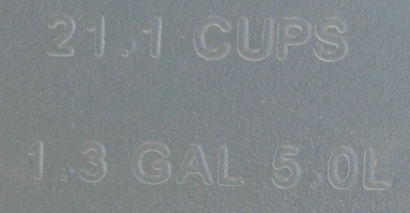
3) get 2kg of brown sugar and 1 cup of rock salt (even 1 ¼ cups is too much salt). Lately I have been experimenting with even less salt.
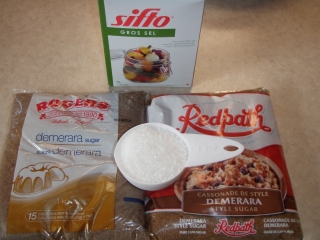
4) get 9 wood pucks ready
i) you will burn 6 pucks so you need 9 pucks, the final 3 simply push the others onto the element
5) prepare the salmon. It will take approximately 6 medium size Fraser sockeye for this recipe, assuming they are 5 to 6 pounds each.
i) fillet the salmon, leaving the tail attached to both fillets
ii) fillet one side of the salmon, leaving the fillet attached near the tail, then flip the fillet over so that it is skin side down, skin each fillet, then vertically cut the meat into approx 1” wide strips. I always leave the portion nearest the tail intact instead of slicing it.
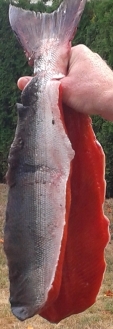
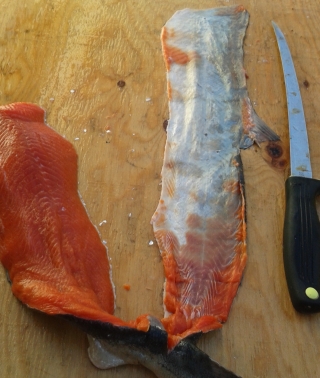
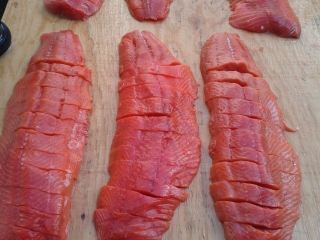
6) make the marinade
i) dump the sugar and salt into any large container, and mix either by hand or use a sturdy spoon.
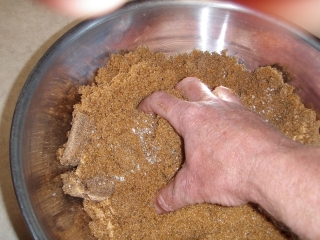
7) begin the marinating
i) place a layer of strips in the container leaving tiny gaps between the strips, if you can. It is okay if the strips touch each other
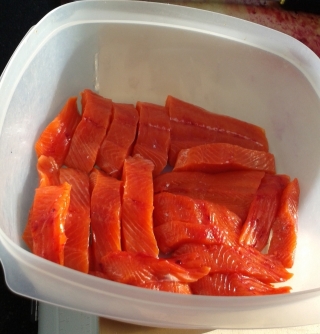
ii) cover the layer with the sugar and salt mix (it is okay if not all of the strips are completely covered), repeat until containers are full. With the containers we use, we get four to five layers of salmon in.
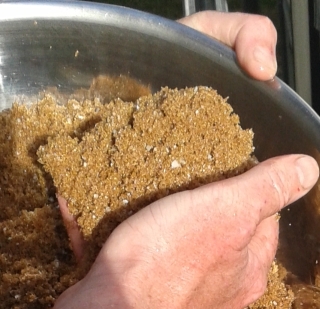
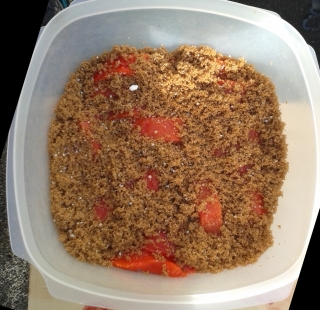
iii) place full containers in the fridge (or a cool place such as a garage) for somewhere near 24 hours
iv) about half way through the marinating process turn the containers upside down to help ensure that the top layer of salmon also gets a good soak. I have learned to do this in the bath tub, because the watertight containers do leak a bit! This means that the salmon is no longer in the fridge, but I return it to the fridge after about 3 hours - right side up again.
8) use a rack oriented normally, and then put another rack on top of it but upside down. This doubles the capacity of the smoker. We bought an extra four racks for the smoker. These new racks have a smaller mesh size so I use them as the bottom rack - see picture.
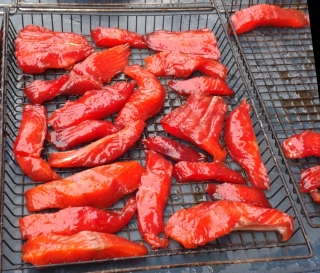
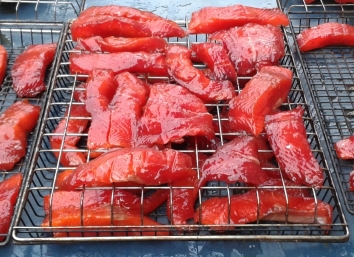
9) transfer the strips from the marinade to the racks
i) I consider 3 common steps to not be worth the time to do: draining the liquid from the containers, rinsing the very few strips that are encrusted in salt, and drying the strips prior to smoking them
ii) grab a double handful of salmon strips then place them on the rack
iii) place strips on racks so that there is a small gap between each strip
iv) this recipe will fill 8 trays, which will have to be stacked in pairs to get 4 stacks
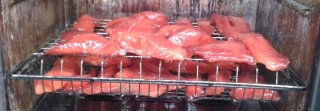
10) smoking - FINALLY!
i) smoke only for 2 hours @ 120ish
ii) keep the strips in the smoker, without smoke for 2 to 3 hours cook @ 150ish; the reason for the variability is personal taste, ambient temp, etc.
iii) with the Bradley digital smoker I have found that it is necessary to add 20 degrees to the temperatures in the 2 steps above.
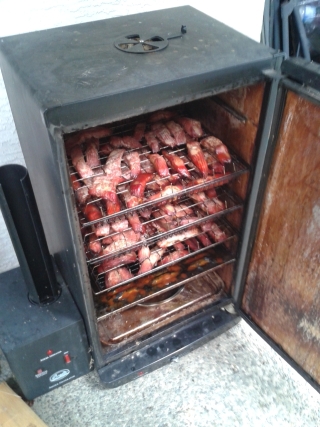
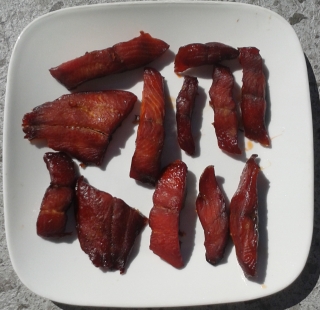
Notes:
a) I clean my smoker with a power washer not using soap
b) all times based on ambient temp of 5-10 celsius
c) put thicker chunks of fish nearer bottom rear of smoker – it is hottest there
d) I rotate the top racks to the bottom and turn each rack a half turn at the halfway point in the cooking stage; the thought being that this helps even the heat application and results in a more uniform product.
e) this process is the fastest and easiest that I have come up with, it tastes excellent, and there is enough variety in the final products that everyone can have some of what they like. Some like it more dry, some like it more moist.
f) if you vacuum bag the product in the 8” wide rolls, and make each bag 8” long, you will get 8 to 10 bags out of this batch, depending on how much you pack in each bag.
g) if you are seeing the fat on the surface of the chunks, consider keeping cooking them for a while longer. This fat doesn’t affect the taste or texture at all.
h) this recipe transfers well to tuna! It takes 10 average Albacore loins to make enough strips for the recipe. I have noticed that tuna seems to absorb the sweetness much more readily than salmon and so am experimenting with less brine altogether when candying tuna.
Due to the requests of several friends, this year I have added pictures.
I am always trying to get the most for the least, this recipe is VERY easy, but ironically produces the best candy that I have ever had.
It is painful to recall how much salmon was rendered unpalatable by my early experiments, but thankfully I persevered!
I wish to acknowledge Wolf and Nog for providing much of the early information that lead to this process.
Enjoy!
1) MAKE SURE your smoker isn’t brand new or the first batch of fish will taste weird (kinda like plastic). If it is new then burn some pucks through it for a few hours first.
2) get 2 containers approximately 9.5” x 9.5” x 4.5” or 5.0L each.
i) it is better if the containers have tight lids so you can turn them upside down during the marinating process. We got our Rubbermaid ones from Canadian Tire, and save them for this activity only.
3) get 2kg of brown sugar and 1 cup of rock salt (even 1 ¼ cups is too much salt). Lately I have been experimenting with even less salt.
4) get 9 wood pucks ready
i) you will burn 6 pucks so you need 9 pucks, the final 3 simply push the others onto the element
5) prepare the salmon. It will take approximately 6 medium size Fraser sockeye for this recipe, assuming they are 5 to 6 pounds each.
i) fillet the salmon, leaving the tail attached to both fillets
ii) fillet one side of the salmon, leaving the fillet attached near the tail, then flip the fillet over so that it is skin side down, skin each fillet, then vertically cut the meat into approx 1” wide strips. I always leave the portion nearest the tail intact instead of slicing it.
6) make the marinade
i) dump the sugar and salt into any large container, and mix either by hand or use a sturdy spoon.
7) begin the marinating
i) place a layer of strips in the container leaving tiny gaps between the strips, if you can. It is okay if the strips touch each other
ii) cover the layer with the sugar and salt mix (it is okay if not all of the strips are completely covered), repeat until containers are full. With the containers we use, we get four to five layers of salmon in.
iii) place full containers in the fridge (or a cool place such as a garage) for somewhere near 24 hours
iv) about half way through the marinating process turn the containers upside down to help ensure that the top layer of salmon also gets a good soak. I have learned to do this in the bath tub, because the watertight containers do leak a bit! This means that the salmon is no longer in the fridge, but I return it to the fridge after about 3 hours - right side up again.
8) use a rack oriented normally, and then put another rack on top of it but upside down. This doubles the capacity of the smoker. We bought an extra four racks for the smoker. These new racks have a smaller mesh size so I use them as the bottom rack - see picture.
9) transfer the strips from the marinade to the racks
i) I consider 3 common steps to not be worth the time to do: draining the liquid from the containers, rinsing the very few strips that are encrusted in salt, and drying the strips prior to smoking them
ii) grab a double handful of salmon strips then place them on the rack
iii) place strips on racks so that there is a small gap between each strip
iv) this recipe will fill 8 trays, which will have to be stacked in pairs to get 4 stacks
10) smoking - FINALLY!
i) smoke only for 2 hours @ 120ish
ii) keep the strips in the smoker, without smoke for 2 to 3 hours cook @ 150ish; the reason for the variability is personal taste, ambient temp, etc.
iii) with the Bradley digital smoker I have found that it is necessary to add 20 degrees to the temperatures in the 2 steps above.
Notes:
a) I clean my smoker with a power washer not using soap
b) all times based on ambient temp of 5-10 celsius
c) put thicker chunks of fish nearer bottom rear of smoker – it is hottest there
d) I rotate the top racks to the bottom and turn each rack a half turn at the halfway point in the cooking stage; the thought being that this helps even the heat application and results in a more uniform product.
e) this process is the fastest and easiest that I have come up with, it tastes excellent, and there is enough variety in the final products that everyone can have some of what they like. Some like it more dry, some like it more moist.
f) if you vacuum bag the product in the 8” wide rolls, and make each bag 8” long, you will get 8 to 10 bags out of this batch, depending on how much you pack in each bag.
g) if you are seeing the fat on the surface of the chunks, consider keeping cooking them for a while longer. This fat doesn’t affect the taste or texture at all.
h) this recipe transfers well to tuna! It takes 10 average Albacore loins to make enough strips for the recipe. I have noticed that tuna seems to absorb the sweetness much more readily than salmon and so am experimenting with less brine altogether when candying tuna.
Last edited by a moderator:



